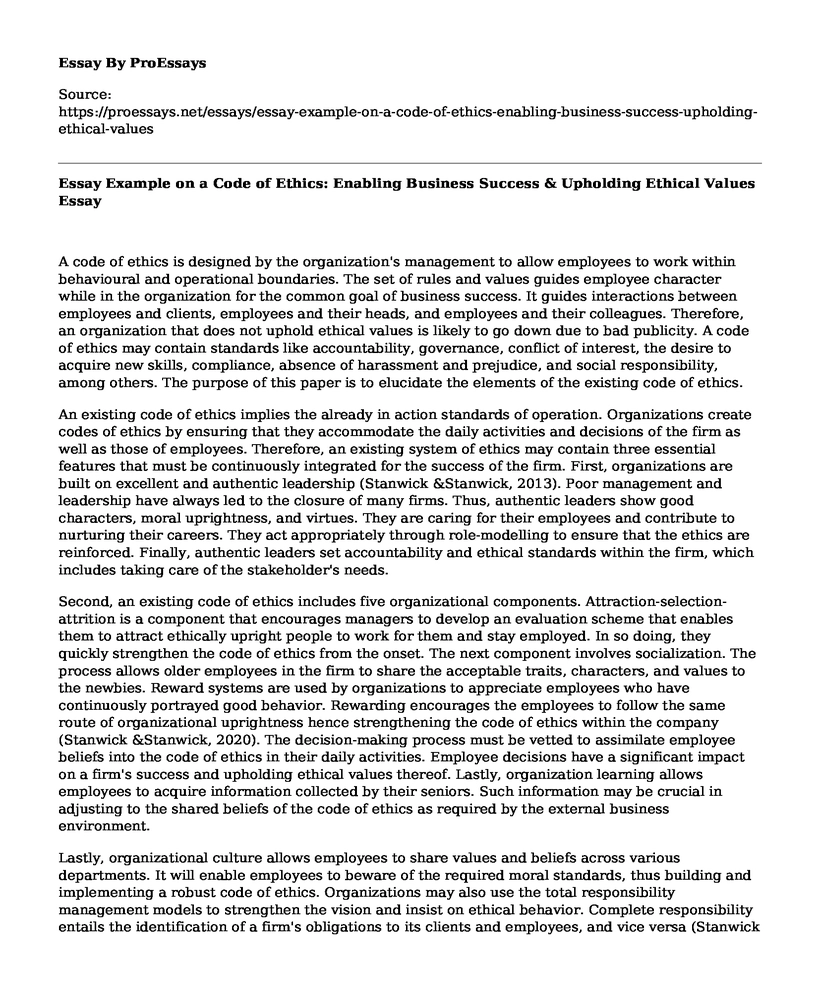A code of ethics is designed by the organization's management to allow employees to work within behavioural and operational boundaries. The set of rules and values guides employee character while in the organization for the common goal of business success. It guides interactions between employees and clients, employees and their heads, and employees and their colleagues. Therefore, an organization that does not uphold ethical values is likely to go down due to bad publicity. A code of ethics may contain standards like accountability, governance, conflict of interest, the desire to acquire new skills, compliance, absence of harassment and prejudice, and social responsibility, among others. The purpose of this paper is to elucidate the elements of the existing code of ethics.
An existing code of ethics implies the already in action standards of operation. Organizations create codes of ethics by ensuring that they accommodate the daily activities and decisions of the firm as well as those of employees. Therefore, an existing system of ethics may contain three essential features that must be continuously integrated for the success of the firm. First, organizations are built on excellent and authentic leadership (Stanwick &Stanwick, 2013). Poor management and leadership have always led to the closure of many firms. Thus, authentic leaders show good characters, moral uprightness, and virtues. They are caring for their employees and contribute to nurturing their careers. They act appropriately through role-modelling to ensure that the ethics are reinforced. Finally, authentic leaders set accountability and ethical standards within the firm, which includes taking care of the stakeholder's needs.
Second, an existing code of ethics includes five organizational components. Attraction-selection-attrition is a component that encourages managers to develop an evaluation scheme that enables them to attract ethically upright people to work for them and stay employed. In so doing, they quickly strengthen the code of ethics from the onset. The next component involves socialization. The process allows older employees in the firm to share the acceptable traits, characters, and values to the newbies. Reward systems are used by organizations to appreciate employees who have continuously portrayed good behavior. Rewarding encourages the employees to follow the same route of organizational uprightness hence strengthening the code of ethics within the company (Stanwick &Stanwick, 2020). The decision-making process must be vetted to assimilate employee beliefs into the code of ethics in their daily activities. Employee decisions have a significant impact on a firm's success and upholding ethical values thereof. Lastly, organization learning allows employees to acquire information collected by their seniors. Such information may be crucial in adjusting to the shared beliefs of the code of ethics as required by the external business environment.
Lastly, organizational culture allows employees to share values and beliefs across various departments. It will enable employees to beware of the required moral standards, thus building and implementing a robust code of ethics. Organizations may also use the total responsibility management models to strengthen the vision and insist on ethical behavior. Complete responsibility entails the identification of a firm's obligations to its clients and employees, and vice versa (Stanwick &Stanwick, 2020). In so doing, the management will integrate such needs in the code of ethics and enforce it for the benefit of all.
Conclusively, the code of ethics covers employees, clients, and the firm's management. The management develops the standards by looking at the needs of its relevant stakeholders. Additionally, the business's external environment also has a significant impact on the development of the code of ethics. A system of ethics contains features such as accountability, compliance, and social responsibility. Contrarily, an existing code of ethics includes the five organizational components, authentic leadership, and corporate culture that must be upheld for the success of the firm.
References
Stanwick, P., & Stanwick, S. (2020). International Management: A Stakeholder Approach. Edward Elgar Publishing. https://books.google.com/books?hl=en&lr=&id=gP7LDwAAQBAJ&oi=fnd&pg=PT9&dq=elements+of+a+living+code+of+ethics+by+peter+and+sarah+stanwick&ots=OzfnJFz7hY&sig=WPc-6xFFzgSGJX6BxdyQr1G8DbU
Stanwick, P., & Stanwick, S. D. (2013). Understanding business ethics. Sage. https://books.google.com/books?hl=en&lr=&id=SpPUrOhQ7I4C&oi=fnd&pg=PR1&dq=elements+of+a+living+code+of+ethics+by+peter+and+sarah+stanwick&ots=NHR4FN_NnP&sig=yx9IZ6a-HvSpUAsaPX3ce1rn2ss
Cite this page
Essay Example on a Code of Ethics: Enabling Business Success & Upholding Ethical Values. (2023, May 17). Retrieved from https://proessays.net/essays/essay-example-on-a-code-of-ethics-enabling-business-success-upholding-ethical-values
If you are the original author of this essay and no longer wish to have it published on the ProEssays website, please click below to request its removal:
- Drivers of Internationalization of Business - Essay Sample
- The Technology Employed by Tres Latin Foods Companies Paper Example
- Solutions to International Business Scenarios and Problems Essay
- Domino's Pizza Case Study Report
- International Expansion: Navigating the Competitive Global Marketplace - Research Paper
- Jerry and Crew in Difficult Situation: Evaluation and Suggestion - Essay Sample
- Essay Example on Grow Business with GYB & DYB: Augmenting Business Sustainability







